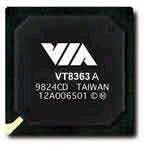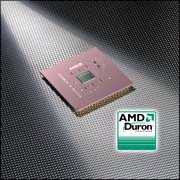KT133A: Performance for Less
Article - a cost-effective hardware upgrade for AMD buyers? Surely not
The VIA KT133A motherboard chipset is an unlikely creature. It offers a higher system bus, ergo improved performance on bandwidth-heavy tasks, yet does not require the user to spend copious amounts of money on expensive DDR memory. In short, it's a go-between for users of the KT133 not so eager to upgrade to the AMD 760. If you are starting to feel the pain of an outdated setup, a KT133A-based product may be the motherboard that sets you up for the next few years.

A Whole New World
Back when the Thunderbird Athlons were first introduced, the KT133 was the chip to have on your motherboard. Market-leaders like Gigabyte and AOpen started shovelling out military-strength OEM motherboards whilst overclocking specialists ABit and ASUS also jumped on the bandwagon with tweak-heavy 'boards. Since then we have learnt, rather depressingly that beyond the 1.1GHz CPU, there won't be much in the way of upgrades for users of the KT133. The 1.2GHz and above Athlons, which will hit the market shortly, are intended for the higher grade DDR chipsets, and those with a higher front side bus. It was enough to make even the most fanatical hardware guru feel mightily short-changed. DDR is the way forward though, or at least, higher bus speeds are. For the Athlons to improve over time, they must increase their memory bandwidth. In the future, as more programs benefit from DDR, performance increases of up to 50% over current technology could well emerge. At the moment though, all the signs point to a mere 10% increase in practical terms, over the KT133, something that can hardly be used to justify the expenditure. There everyone was, lambasting the Pentium 4 for its far-off aspirations, and suddenly AMD plunged themselves into the same hole, and the pre-Christmas market for PCs became a minefield. Of course, this is where the KT133A from VIA comes in. It supports a higher bus speed, of 266MHz, it doesn't require new memory beyond PC133 SDRAM to operate it, and it supports current and future AMD Athlons and Durons, rated beyond 1.7GHz. Sorted.

The Meaning
Of course, the chief concerns of many is just how much of a performance hit the platform takes using a 266MHz DDR bus with the SDRAM that the average computer user owns, and how it improves performance without actually increasing memory bandwidth. The answer is that the Athlon doesn't really need quite that much of it, yet. If you run clock-speed independent bandwidth tests using the 760 chipset and PC2100 DDR-RAM, the difference in performance between it and the KT133 is close to 50%, lagging quite a way behind the Pentium 4 using RDRAM. However, upon downgrading the Pentium 4 setup to a slower type of RDRAM that should theoretically be unable to push as much data as the DDR, you discover that the Athlon is still a fair whack behind. What gives? The fact of the matter is that the Athlon doesn't really need the peak bandwidth capabilities of the 760 chipset yet. The design isn't yet aimed at having huge amounts of memory bandwidth to stream from. Hold up a second though, you may say. Why was there a 50% increase in performance over the KT133 if the memory bandwidth of DDR is having no real discernible benefit? Because, dear reader, the 133MHz DDR bus speed is that much of an improvement over the KT133, and that is what the KT133A offers without the associated memory costs.

How Much?
Lets recap for a second; the KT133 uses a 100MHz DDR bus, and standard SDRAM. The AMD 760 uses a 133MHz DDR bus, and can also use PC2100 DDR memory, with peak memory bandwidth capabilities of 2.1Gb/s. The KT133A fills the gap, by utilizing the 133MHz DDR bus using standard SDRAM, because current Athlons and those probably quite a lot of the future releases don't rely on streaming from memory bandwidth. The next question to ask is, how much of a performance increase can people upgrading from the KT133 look at using existing Athlons? The thing to point out here is, that although running a current Athlon with a bus speed of 133MHz DDR should be feasible, it is not something AMD are willing to guarantee. In our testing, we used a 900MHz Athlon and a 650MHz Duron, both with their multipliers unlocked (a key point, we might add). In order not to exceed the stated clock speeds of the two CPUs too much, we tried to match the new frequency to the old one as closely as possible. So to this end, we used a 6.5 multiplier with the 900MHz Athlon to give us 6.5x133 = 866MHz, and a multiplier of 5 with the 650MHz Duron to give us 5x133 = 667MHz. In both cases, the PC operated perfectly and without defect for an extended period of time using CPU heavy processes such as MP3-ripping, MPEG4-encoding and of course 3D games. They seemed fine.

The Rest
Once we had dispensed with the pleasantries, we also attempted to overclock the two CPUs. The Athlon reached 1.13GHz (8.5x133) and the Duron 933MHz (7x133). Logic of course dictates that overclocking to an even higher bus speed would result in higher performance. Using the Athlon at 7.5x150 proved a success, as did using the Duron at 6x150. However, it bears noting here that although our memory (Crucial-made PC133 SDRAM) is rated to 150MHz, the likelihood of yours being so without purpose-buying it is very slim. All things considered, the KT133A is something of a white knight for the hardware industry. It offers vastly improved performance in many processes and should operate fine with current CPUs and memory, although if you only have PC100, you may need to trade it in for some PC133. With memory prices the way they are though, this will cost very little indeed. The only question that remains to be answered is, are you future-proofed if you buy a KT133A-based motherboard? All the signs point to yes. It will support future Athlon processors, many say for as far as the Socket A CPUs go, and it will in all likelihood stand up to whatever's available in a year's time, in a similar manner to the Intel BX chipset, which plodded along for many a year filling in the gaps.
Conclusion
If you are entering the market for a Socket A Athlon for the first time, it's a no-brainer; the KT133A and some PC133 memory is both the cheapest and at the moment best-performing solution. For existing KT133 users, it's a little tougher. If you choose to upgrade to the KT133A now, the chances are you can sell off your KT133 board to recoup some of the cost and reap the performance benefits. Consider what we've said, and judge for yourselves what to do. Related Features:- Socket A Overclocking AMD Athlon Review AMD Duron Review








